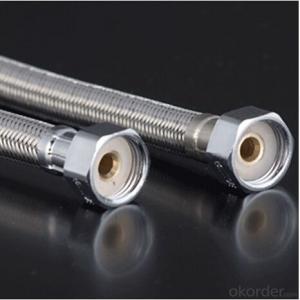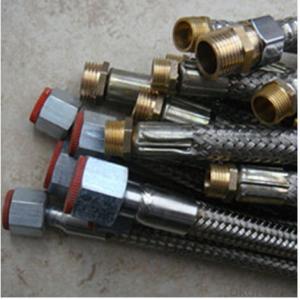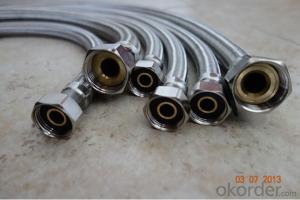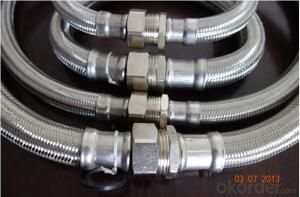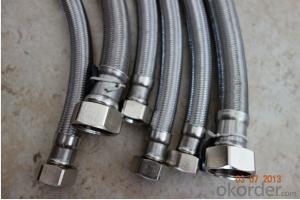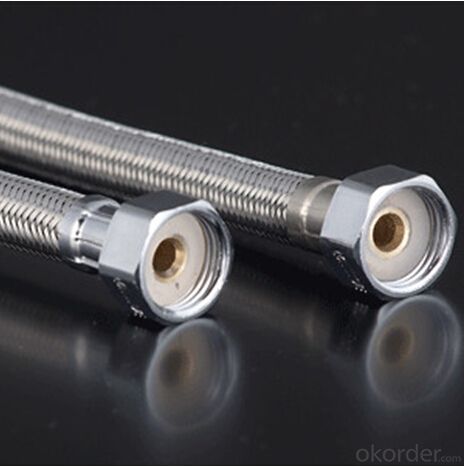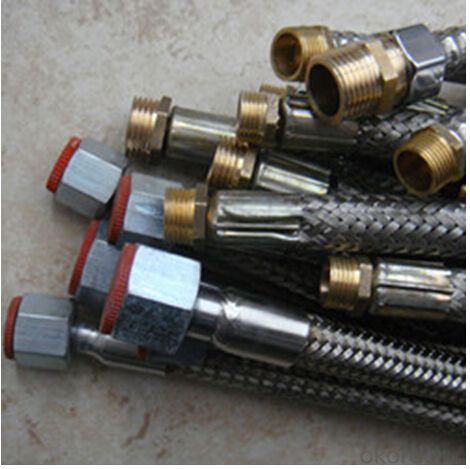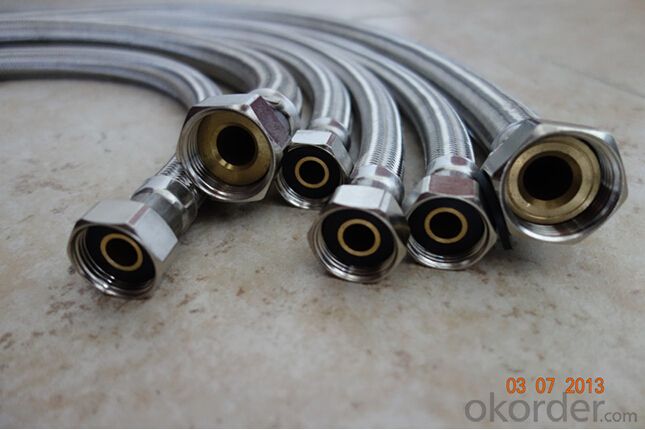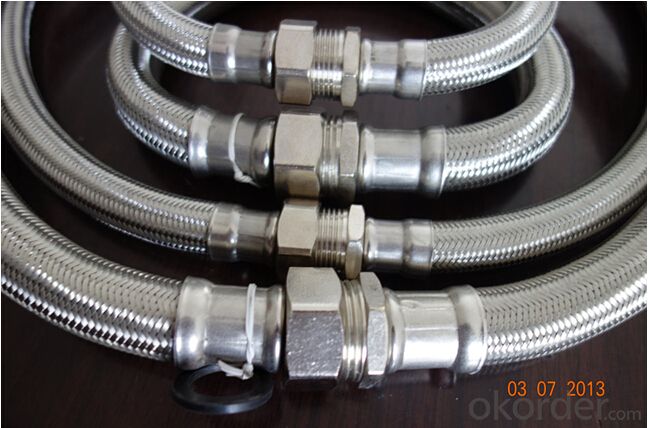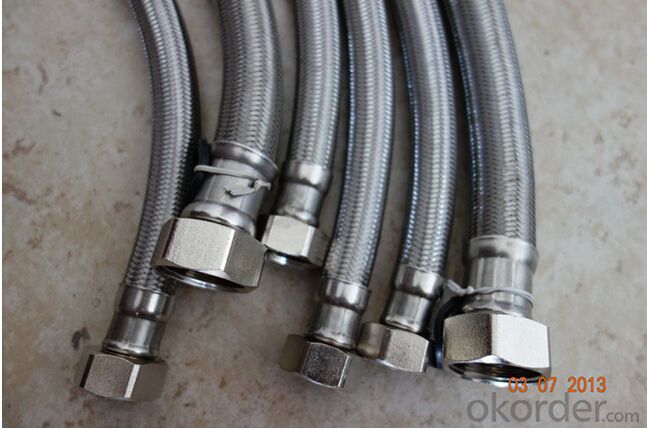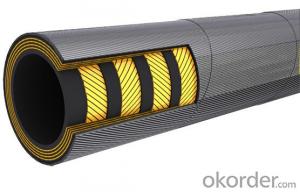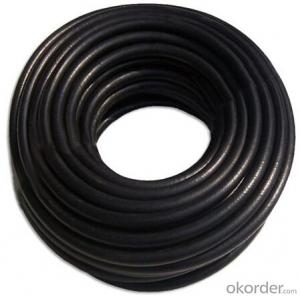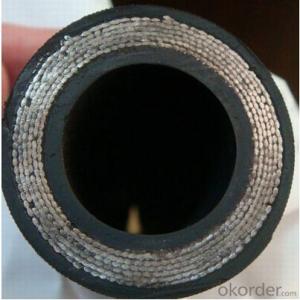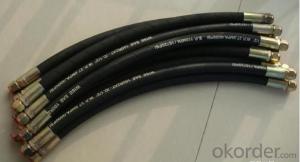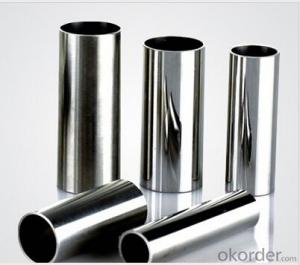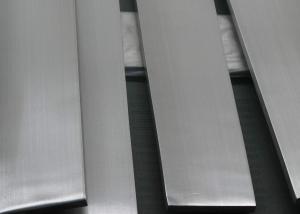Rubber Metal Hose with High Pressure Corrugated
- Loading Port:
- Tianjin
- Payment Terms:
- TT OR LC
- Min Order Qty:
- 1000 pc
- Supply Capability:
- 100000 pc/month
OKorder Service Pledge
OKorder Financial Service
You Might Also Like
Specification
Rubber Metal Hose with High Pressure Corrugated
Applications of Rubber Metal Hose with High Pressure Corrugated:
--Refueling system
--Chemical and pharmaceutical industry
--Industrial hydraulic systems
--Air conditioners in industrial and construction –site vehicles
--Food and beverage industry
--Special and standard industrial applications
--Water and cleaning management
Features of Rubber Metal Hose with High Pressure Corrugated:
1. )O. D.: 13-18MM 0.2-3M long
2. )Nut.: Nickel/Chrome Plated Brass (Zinc / Iron / Aluminum is available)
3. )Size Of Nut.: Female&Male 1/2''; 3/4''; 3/8''; 7/8''; 5/16'', and M10...
4. )Insert.: Brass (Zinc / Aluminum / Plastic is available)
5. )Inner tube.: Rubber/ EPDM/PVC
6. )Covered Material: Stainless Steel 201, 301, 304 /Aluminium Wire
7. )Working Pressure: 5Kg-15Kg
8. )Temperature: 0-92° C
9. )Quality Assurance: 3 years
RemarkAPPLICATION: HOUSEEHOLD WARE, BATHROOM WARE, SHOWER HOSE
PAYMENT: T/T, L/C
DELIVERY TIME: 20DAYS OR 30DAYS AFTER RECEIVED 30% DEPOSITS
MOQ: 5000PCS
ODM&OEM IS ACCEPTABLE
PackageInner: PP bag /Blister packing Outer: Carton box
Specifications of Rubber Metal Hose with High Pressure Corrugated:
NO | I.D | Refer to O.D | Working pressure | Burst pressure | approximate Weight | |||||
(inch) | (mm) | (inch) | (mm) | MPa | Psi | MPa | Psi | kg/m | lbs/ft | |
1 | 1/8 | 3.2±0.2 | 0.35 | 9±0.3 | 2.06 | 300 | 8.27 | 1200 | 0.078 | 0.12 |
2 | 5/32 | 4±0.2 | 0.4 | 10±0.3 | 2.06 | 300 | 8.27 | 1200 | 0.092 | 0.14 |
3 | 3/16 | 4.8±0.2 | 0.43 | 11±0.3 | 2.06 | 300 | 8.27 | 1200 | 0.108 | 0.16 |
4 | 1/4 | 6.3±0.3 | 0.5 | 12.7±0.3 | 2.06 | 300 | 8.27 | 1200 | 0.134 | 0.2 |
5 | 5/16 | 8.0±0.3 | 0.56 | 14±0.3 | 2.06 | 300 | 8.27 | 1200 | 0.147 | 0.22 |
6 | 3/8 | 9.5±0.3 | 0.63 | 16±0.4 | 2.06 | 300 | 8.27 | 1200 | 0.182 | 0.27 |
7 | 15/32 | 12±0.3 | 0.75 | 19±0.5 | 2.06 | 300 | 8.27 | 1200 | 0.238 | 0.35 |
8 | 1/2 | 12.7±0.4 | 0.78 | 20±0.5 | 2.06 | 300 | 8.27 | 1200 | 0.262 | 0.39 |
9 | 5/8 | 16±0.4 | 0.94 | 24±0.5 | 1.03 | 150 | 4.12 | 600 | 0.351 | 0.52 |
10 | 3/4 | 19±0.4 | 1.13 | 28.8±0.5 | 1.03 | 150 | 4.12 | 600 | 0.515 | 0.77 |
11 | 1 | 25.4±0.5 | 1.38 | 35±0.6 | 1.03 | 150 | 4.12 | 600 | 0.637 | 0.95 |
Images of Rubber Metal Hose with High Pressure Corrugated:
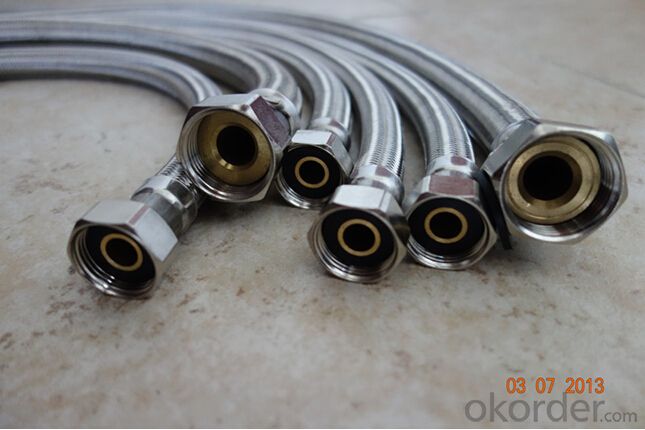
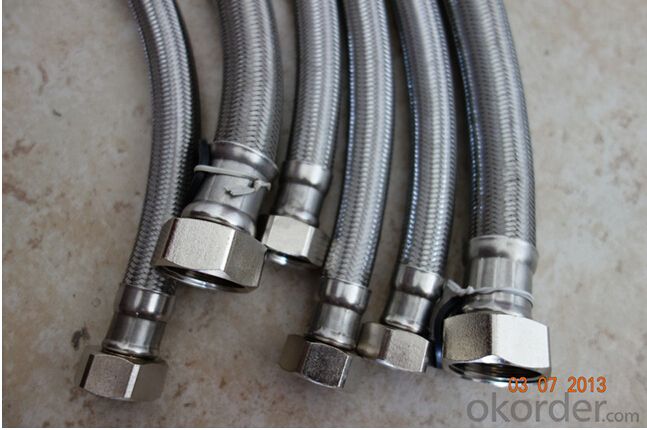
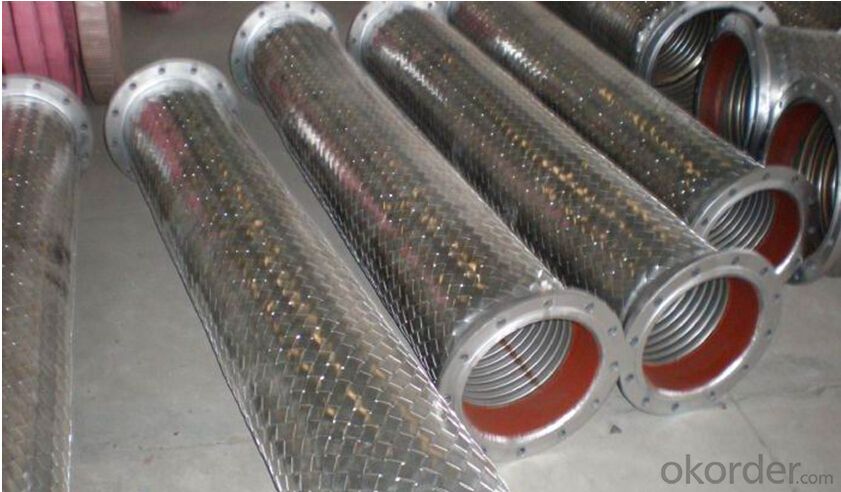
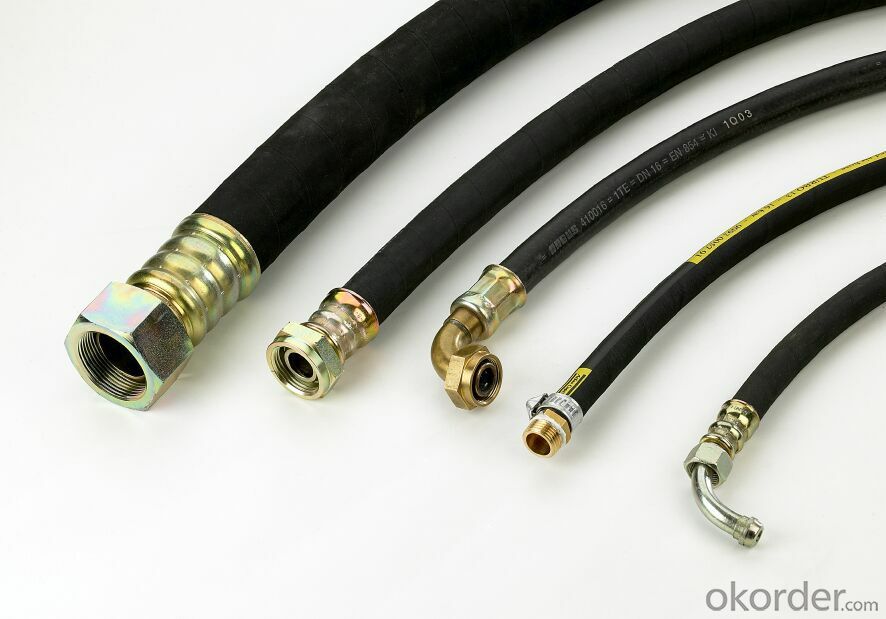
Package of Rubber Metal Hose with High Pressure Corrugated:
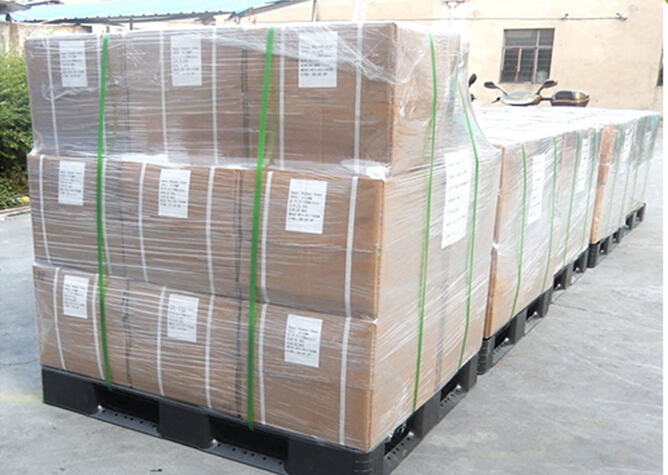

FAQ of Rubber Metal Hose with High Pressure Corrugated:
Who we are:
Answer: We CNBM is a Chinese state-owned enterprise ranked 267th among the Global Fortune 500, as the largest building materials company,we have over 300 affiliated companies,and so many production lines and branch office distribute in China.
2. About our quality:
Answer: Every product needs to be quality proved before shipping.
3. About our service:
Answer: We could gurantte that we can reply you in 2 working hours.
- Q: Can stainless steel pipes be used in the water treatment industry?
- Indeed, the water treatment industry can utilize stainless steel pipes. Due to its exceptional resistance to corrosion, stainless steel proves to be a fitting material for environments involved in water treatment and processing. It finds widespread application within the industry, encompassing pipelines, pumps, valves, and tanks. The strength and durability of stainless steel pipes are commendable, guaranteeing enduring performance even under severe circumstances. Moreover, stainless steel boasts hygienic properties and is effortless to clean, which renders it perfect for applications where upholding water purity is paramount. All in all, stainless steel pipes emerge as a dependable and cost-efficient alternative for the water treatment industry.
- Q: Can stainless steel pipes be used for food processing equipment?
- Stainless steel pipes have the capability to be utilized for food processing equipment. The food industry highly favors stainless steel due to its ability to resist corrosion, its durability, and its hygienic properties. It does not interact with food or beverages, guaranteeing the absence of contamination or alteration of the product. In addition, stainless steel pipes are easily cleaned and maintained, making them an ideal option for use in food processing equipment where cleanliness and food safety are crucial. Furthermore, stainless steel has the capacity to endure high temperatures and pressures, which are often necessary in food processing operations. In conclusion, stainless steel pipes are a suitable choice for food processing equipment and are extensively employed in the industry.
- Q: What are the different types of stainless steel pipe coatings?
- There are several types of stainless steel pipe coatings that are used to enhance the durability, corrosion resistance, and aesthetic appearance of the pipes. Some of the common types of stainless steel pipe coatings include: 1. Fusion Bonded Epoxy (FBE) Coating: FBE coating is a thermosetting resin-based coating that is applied to the pipes using an electrostatic spray. It provides excellent corrosion resistance and adhesion, making it suitable for both buried and above-ground applications. 2. Polyethylene (PE) Coating: PE coating is a thermoplastic coating that is applied to the pipes using extrusion. It provides high impact resistance and excellent resistance to chemical substances, making it suitable for pipes used in harsh environments. 3. Polypropylene (PP) Coating: PP coating is a thermoplastic coating similar to PE coating but with higher temperature resistance. It is often used for pipes that transport high-temperature fluids. 4. Polyurethane (PU) Coating: PU coating is a thermosetting resin-based coating that is applied to the pipes using a spray or dip method. It provides excellent resistance to abrasion, impact, and chemicals, making it suitable for pipes used in demanding applications. 5. Zinc Coating: Zinc coating, also known as galvanization, is a metallic coating that is applied to the pipes using a hot-dip process. It provides excellent corrosion resistance and is commonly used for pipes used in outdoor and underground applications. 6. Ceramic Coating: Ceramic coating is a high-temperature resistant coating that is applied to the pipes using a thermal spray process. It provides excellent resistance to abrasion, oxidation, and corrosion, making it suitable for pipes used in high-temperature environments. 7. PTFE (Polytetrafluoroethylene) Coating: PTFE coating is a non-stick coating that is applied to the pipes using a spray or dip method. It provides excellent resistance to chemicals and high temperatures, making it suitable for pipes used in the chemical and food industries. These are just a few examples of the different types of stainless steel pipe coatings available. The choice of coating depends on the specific requirements of the application, such as the type of fluid being transported, the operating temperature and pressure, and the environmental conditions.
- Q: Can stainless steel pipes be insulated with polysulfone?
- Stainless steel pipes can indeed be insulated with polysulfone. Polysulfone is a highly durable and heat-resistant material that is commonly used for insulation purposes. It has excellent thermal insulation properties, making it suitable for insulating stainless steel pipes in various applications. Additionally, polysulfone is known for its resistance to chemicals, making it a suitable choice for environments where corrosion or chemical exposure is a concern. However, it is important to ensure that the polysulfone insulation is compatible with the specific requirements and temperatures of the stainless steel pipes being insulated. Consulting with a professional or referring to the manufacturer's guidelines can help determine the suitability of using polysulfone insulation for stainless steel pipes in a particular application.
- Q: How do you calculate the heat transfer coefficient of stainless steel pipes?
- The heat transfer coefficient of stainless steel pipes can be calculated using empirical correlations or experimental measurements. Empirical correlations involve using equations that relate the heat transfer coefficient to parameters such as the flow rate, pipe diameter, and fluid properties. These correlations are often based on extensive experimental data and can provide reasonably accurate estimates. Alternatively, experimental measurements involve directly measuring the temperature difference across the pipe wall and the heat flux. By dividing the heat flux by the temperature difference, the heat transfer coefficient can be obtained. However, experimental measurements can be more time-consuming and may require specialized equipment.
- Q: Are stainless steel pipes magnetic?
- Yes, stainless steel pipes can be magnetic, depending on the specific grade of stainless steel. Stainless steel is an alloy made primarily of iron, with varying amounts of chromium, nickel, and other elements. The presence of these elements affects the magnetic properties of the stainless steel. Generally, stainless steel grades that contain a higher amount of chromium and nickel, such as the austenitic grades (e.g., 304, 316), are non-magnetic. On the other hand, stainless steel grades that have a higher amount of ferrite, such as the martensitic and ferritic grades, can be magnetic. Therefore, it is important to consider the specific grade of stainless steel when determining its magnetic behavior.
- Q: How do you pressure test stainless steel pipes?
- Pressure testing stainless steel pipes is an essential step to ensure their integrity and safety. Here is a step-by-step guide on how to pressure test stainless steel pipes: 1. Prepare the pipes: Before starting the pressure test, ensure that the stainless steel pipes are clean and free from any debris or contaminants. Inspect the pipes for any visible defects, such as cracks or leaks, and repair or replace them if necessary. 2. Gather the necessary equipment: You will need a pressure testing pump or equipment capable of generating the desired pressure, pressure gauges, and suitable seals or plugs to close off the pipe ends. 3. Determine the required pressure: Consult the engineering specifications or relevant industry standards to determine the appropriate pressure to which the stainless steel pipes should be tested. This pressure is usually specified in pounds per square inch (psi). 4. Close off the pipe ends: Use suitable seals or plugs to close off all the ends of the stainless steel pipes. Ensure that the seals or plugs are securely attached to prevent any leakage during the pressure test. 5. Connect the pressure testing equipment: Connect the pressure testing pump or equipment to one end of the pipe using a pressure gauge to monitor the pressure accurately. Make sure the connections are tight and leak-proof. 6. Apply pressure gradually: Slowly increase the pressure in the stainless steel pipes using the pressure testing pump or equipment. Monitor the pressure gauge closely and ensure it reaches and stabilizes at the desired testing pressure. This process should be done gradually to avoid sudden pressure surges that could potentially damage the pipes. 7. Maintain the pressure: Maintain the pressure at the desired level for a specified duration, typically as recommended by the engineering specifications or standards. This duration could range from a few minutes to several hours depending on the application and requirements. 8. Inspect for leaks: While maintaining the pressure, carefully inspect the stainless steel pipes for any signs of leakage. Look for any visible leaks, listen for hissing sounds, or use a leak-detection solution or soapy water to identify any escaping air or bubbles. If leaks are detected, stop the pressure test and address the issue before proceeding. 9. Release the pressure: Once the pressure test is completed, gradually release the pressure from the stainless steel pipes using the pressure testing pump or equipment. Take caution while releasing the pressure to prevent sudden decompression that could potentially damage the pipes. 10. Evaluate the results: Inspect the stainless steel pipes again after the pressure test to ensure no new leaks or defects have emerged. If the pipes have successfully passed the pressure test without any issues, they can be considered safe and suitable for their intended application. It is important to note that pressure testing stainless steel pipes should be conducted by qualified personnel following industry standards and guidelines to ensure accuracy and safety.
- Q: What is the difference between seamless and cold-drawn stainless steel pipes?
- Seamless and cold-drawn stainless steel pipes are two different types of stainless steel pipes that vary in their manufacturing processes and properties. Seamless stainless steel pipes are manufactured without any welding or seams. They are made by piercing a solid cylindrical billet or ingot of stainless steel and then rolling it into a hollow tube shape. This seamless manufacturing process ensures that there are no weak points or areas prone to leakage, making seamless pipes highly durable and reliable. They also have a smoother interior surface, which allows for efficient fluid flow and reduces the risk of corrosion. On the other hand, cold-drawn stainless steel pipes are manufactured by pulling or drawing a solid stainless steel billet through a series of dies at room temperature. This process helps in achieving precise dimensions and a smooth surface finish. Cold-drawn pipes are typically used in applications where tight tolerances and a high-quality surface finish are required. They are known for their superior dimensional accuracy, excellent surface finish, and increased strength. In terms of properties, seamless stainless steel pipes offer better resistance to corrosion, higher strength, and increased pressure rating compared to cold-drawn pipes. The absence of welds also makes seamless pipes less prone to cracking or failure under high-pressure environments. On the other hand, cold-drawn stainless steel pipes are known for their excellent surface finish, close dimensional tolerances, and improved mechanical properties, making them suitable for applications that require precise measurements and a smooth appearance. In summary, the main difference between seamless and cold-drawn stainless steel pipes lies in their manufacturing processes, resulting properties, and applications. Seamless pipes are manufactured without any welding or seams, offering better resistance to corrosion and higher strength, while cold-drawn pipes are made by pulling solid stainless steel through dies, providing excellent surface finish, dimensional accuracy, and improved mechanical properties.
- Q: How do you calculate the weight of stainless steel pipes?
- To calculate the weight of stainless steel pipes, you need to know the outer diameter, wall thickness, and length of the pipe. Using these measurements, you can apply the formula: weight = (outer diameter - wall thickness) x wall thickness x length x density of stainless steel. The density of stainless steel is typically around 7.9 grams per cubic centimeter.
- Q: Are stainless steel pipes resistant to caustic environments?
- Yes, stainless steel pipes are generally resistant to caustic environments.
Send your message to us
Rubber Metal Hose with High Pressure Corrugated
- Loading Port:
- Tianjin
- Payment Terms:
- TT OR LC
- Min Order Qty:
- 1000 pc
- Supply Capability:
- 100000 pc/month
OKorder Service Pledge
OKorder Financial Service
Similar products
Hot products
Hot Searches
Related keywords
